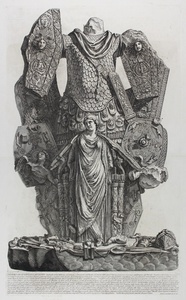| Method | Etching |
| Artist | Giovanni Battista Piranesi |
| Published | Piranesi Architetto dis. ed inc. [Rome, Bouchard, c.1753] |
| Dimensions | Image 590 x 390 mm, Plate 650 x 400 mm, Sheet 805 x 590 mm |
| Notes |
An illustration of one of a pair of Roman marble military trophies, the main focus of Piranesi's Trofei di Ottaviano Augusto. The trophies were excavated from the nymphaeum of the Aqua Julia and set up on the balustrade of the Capitoline Piazza by Pope Sixtus V in 1590, and came to be known as the Trofei di Mario, under the mistaken assumption that they commemorated Marius' victories over the Cimbri and Teutones. Piranesi argues at length in the inscription below the plate for an attribution to Octavian Augustus, in commemoration of his victory at Actium. The nymphaeum itself was almost certainly built in the reign of Alexander Severus, though they are usually described on stylistic grounds as being Flavian, and the inscription set up when they were moved dates them to the reign of Domitian. The sculpture itself depicts a cuirass, a series of shields, various weapons of war and quivers of arrows, a pair of winged male figures, now very fragmentary, and a central captive female figure in a long sleeved tasselled chiton with her arms behind her back. Piranesi's first foray into archaeological survey was the short, but grandiosely titled, volume Trofei di Ottaviano Augusto innalzati per la Vittoria ad Actium e conquista dell'Egitto con vari altri ornamenti diligentemente ricavati dagli avanzi piu preziosi delle fabbriche antiche di Roma, utili a pittori, scultori ed architetti, designati ed incisi da Giambattista Piranesi, Architetto Veneziano. Taking as its inspiration the two antique trophies that had been set up on the terrace of the Campidoglio in 1590, Piranesi argued for an attribution to Augustus in commemoration of the Battle of Actium. The trophies, which had been rediscovered in an excavation of the fountainhead of the Aqua Julia, were colloquially known as the Trophies of Marius. Piranesi's pamplet contained detailed illustrations of the trophies, as well as a pair of general views and a series of plates depicting other architectural fragments that the artist believed would be of interests to other antiquarians, sculptors, architects, and cognoscenti. Giovanni Battista (also Giambattista) Piranesi (1720 – 1778) was an Italian artist famous for his etchings of Rome and of fictitious and atmospheric "prisons" (the Carceri d'Invenzione). He was a major Italian printmaker, architect and antiquarian. The son of a Venetian master builder, he studied architecture and stage design, through which he became familiar with Illusionism. During the 1740's, when Rome was emerging as the centre of Neoclassicism, Piranesi began his lifelong obsession with the city's architecture. He was taught to etch by Giuseppe Vasi and this became the medium for which he was best known. Wilton-Ely 272, F137, C382 Condition: Strong clean impression. Central horizontal fold as issued. |
| Framing | unmounted |
| Price | £1,000.00 |
| Stock ID | 50557 |

